Enhancing the appearance of the building is available with different materials. Regardless of the type of finish, the requirements for safety, aesthetics and durability are imposed on it. With the development of technology in the construction industry, it became possible to clap a house with a board.
Features and advantages of wood for house cladding
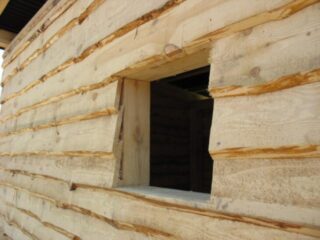
Wood is a popular material for facade decoration. Craftsmen for cladding use a processed and unedged board. This type of cladding is characterized by low costs, attractiveness and long service life, subject to technology.
Different types of materials are used for exterior decoration:
- Larch is the best option due to its resistance to a humid environment, a low level of warpage in comparison with other species. Differs in easy finishing and holds nails securely.
- Spruce is suitable for interior wall decoration due to the large number of knots. For outdoor use, it is not popular due to the appearance of cracks. Unedged spruce board for external cladding is used in rare cases.
- The pine tree warps and quickly deteriorates. The material is relevant for interior work.
- Cedar is a hardwood with a long service life. However, processing is difficult and requires accuracy from the master. Another disadvantage is the high price.
- Oak is considered a durable species and attracts not only builders, but also furniture manufacturers. The wood resists atmospheric precipitation, retaining its function and attractive appearance for many years.
Unedged board is a category of lumber that is produced in different sizes. The peculiarity of the products lies in the fact that the butt end is not cut off. Thanks to this form, the cladding of the house takes on an original look.
When choosing wood, pay attention to the quality of the cut - the product should be free of chips, dents and other defects. The minimum number of knots prevents deformation of the board after drying.
Materials for pre- and finishing
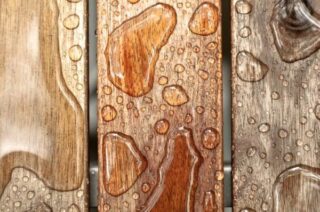
The frame of the building gives the future structure reliability. To do this, use a beam with a section of 20x20 or 30x30 cm. Choose the thickness of the elements based on your preferences and budget.
Before finishing the facade, carry out the preparatory work:
- Cover the lumber with a primer or protective coating. This will increase the wear resistance of the elements and the service life.
- Install waterproofing on the walls. It is recommended to use lubricants. Apply the mastic to the surface with a small brush. Fill the gaps and remove the excess with a spatula. The purpose of the work is to protect the walls and secure the blind area of the building.
- Wait until the first layer of waterproofing is completely dry. Spread the mixture three times to prevent mold.
- Install thermal insulation material. The optimal solution is mineral wool, which is distinguished by fire safety, resistance to temperature extremes and humidity.
You can sheathe the facade with a wooden board in a country cottage or in the country. Finishing is sustainable and makes the building more attractive. After finishing the tiling, treat the board with special oils.Choose paint for outdoor work.
Priming solutions as a topcoat have a short service life. The lack of paintwork on a wooden house leads to the need to regularly use impregnations (2-3 times a year).
List of tools and materials
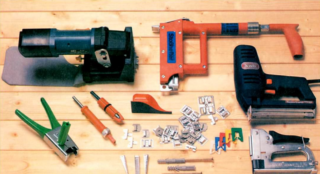
To sheathe the outside of the house, prepare a minimum set of tools and purchase the required amount of lumber, including timber for the frame. It is recommended to choose a 30 cm wide unedged board from northern tree species.
To finish the building you will need:
- pencil and tape measure;
- building level;
- hammer, nails, square;
- hacksaw;
- roller, brush, spatula.
Purchase a silicone-based sealant, mineral wool, and a protective antiseptic to impregnate the surface in advance. Heaters will help to increase thermal insulation. For finishing, you will need wood varnish or paint.
Methods for cladding a house with a board
To finish a building with an unedged board, carry out calculations for the purchase of the required amount of lumber. To do this, calculate the total area to be sheathed and multiply by the selected thickness. As a result, you will get the cubic capacity of wood.
Overlap technology or "American"
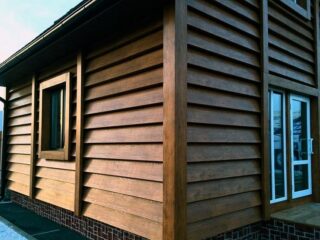
Overlapping boarding is carried out depending on the choice of wood species. It is recommended to use a WPC board (wood-polymer composites) for this method. This type of cladding is also called "American". Thanks to the installation technology, water does not flow down to the basement of the building and is not absorbed into the walls. On the inside, the cladding remains dry.
Unedged boards are available in stores with a thickness of 16, 19, 22 and 25 mm. However, there are also thicker options - from 32 to 75 mm.
Closely
A feature of the technology lies in the need to seal joints and cracks. This is due to the fact that the untreated board has uneven edges. You can eliminate such a defect using a large amount of sealant or caulking materials. This option is considered expensive, since additional elements and parts for cladding will need to be purchased.
Boarding technology at home
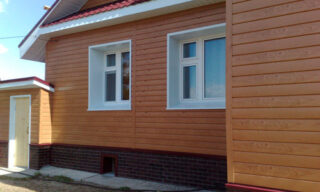
The technology of cladding a house from an unedged board involves the installation of a frame. The structure is designed to level the base. In addition, the lathing eliminates defects resulting from the operation of the building.
Installing the frame
When planning the cladding of a building with an unedged "overlapping" board, approach the construction of the frame responsibly. The lathing, created by technology, ensures a high-quality fit of the elements. The work is carried out according to the following principle:
- From the corner of the house, mark a point at a distance of 15 cm - at this place the first structural element is installed.
- Do the same for the second corner of the building.
- Divide the rest of the building area into equal parts with the width, as for the sheets of thermal insulation.
- In the previously marked places, fix the material used with dowels.
The purpose of installing the frame is to hold the insulation. The design forms a ventilation gap through which condensation is eliminated.
House cladding using overlapping technology
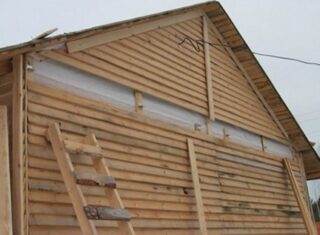
You can sheathe the house with both edged and unedged boards. The first option is a rectangular material ideally cut from all sides. All elements are the same in length and width. The second type of board is presented in stores along with the bark. If it holds securely and does not crumble, it is left. When the bark is not needed, the lumber is cleaned and sanded.
For overlapping house cladding, follow these steps:
- Make a layout of the walls along which the frame will be mounted on the guide rails.
- If you plan to additionally insulate the building, put the appropriate material in the cells.
- Fix the façade boards vertically, then fix the horizontal elements.Use the building level when exposing the details.
- Take nails as fasteners and install in a checkerboard pattern. This approach will prevent the curvature of the canvas with the natural deformation of the tree.
- Each layer of "herringbone" is fixed on the previous one with an overlap of about 2 cm.
If the slats are 10 cm wide, then the overlap should be 23-26 mm on each side. Maintain these proportions throughout the sheathing area. The docking of the elements is closed with flat boards.
Finishing
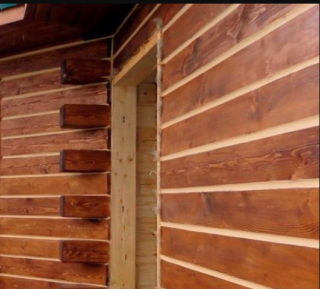
After fixing the facing materials, the joints must be sealed with a sealant. It is recommended to purchase polyurethane compounds with a high degree of elasticity that can withstand strong stretching. For example, WEICON Fast-Bond has good adhesion to all materials, resistance to atmospheric precipitation, UV radiation and aging.
At the final stage, apply a topcoat - varnish or paint. The first option is most often used. For surface treatment, use a small brush and gently apply to each plank.
From unedged boards, you can embody various design ideas. For example, cover a wall with a solid layer, combine lumber with corner posts made of brick or wild stone. You can make imitation of a shindle from hardwood.
Unedged board for house cladding is a budget and original cladding option. Installation does not take much time and does not require specific knowledge or experience. Stick to technology for quality results.








